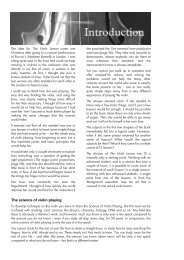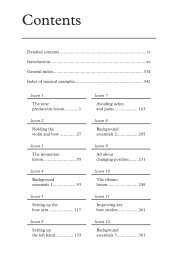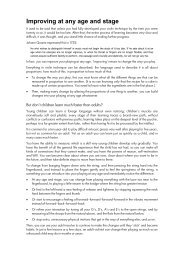here - Simon Fischer
here - Simon Fischer
here - Simon Fischer
You also want an ePaper? Increase the reach of your titles
YUMPU automatically turns print PDFs into web optimized ePapers that Google loves.
Introduction<br />
The music examples in Practice, drawn from the<br />
standard solo violin repertoire, illustrate typical<br />
musical and technical demands that arise during<br />
the normal course of playing.<br />
What are the practice methods for?<br />
Some of the practice methods are ways of improving<br />
tone, intonation, shifting, vibrato, relaxation,<br />
and so on. Some are ways of finding out what the<br />
problems actually are. Often we know that something<br />
is not quite right, but we do not know what<br />
it is or why; or we can get a piece only so far and<br />
then we feel stuck, and do not know what to do<br />
next to improve it.<br />
Some of the practice methods are ways of trying<br />
to cause yourself problems, so that afterwards<br />
what you actually have to do feels easier. Some<br />
methods build and improve technique at the same<br />
time as making a specific passage easier to play, so<br />
that each time you practise them your technique<br />
grows or strengthens. Then all other passages of<br />
that type take less time to learn because they feel<br />
easier to play in the first place.<br />
Making fast progress<br />
Whatever stage you are at in learning a piece, the<br />
fastest progress comes from being able to look at<br />
a phrase or passage from many different angles.<br />
Then it is much easier to isolate whatever changes<br />
need to be made, either musical or technical. The<br />
more ways you have of taking a passage apart and<br />
putting it back together again, the better. Practice<br />
contains a large repertoire of widely varied methods,<br />
and you can quickly move from one to another,<br />
improving the phrase or passage with each new<br />
approach.<br />
How long do they take?<br />
Most of the practice methods should end up as<br />
something that you do for a matter of seconds,<br />
even if they take half a page to describe in words,<br />
and five minutes to do for the first time if the idea<br />
is new to you. For example, once you know how<br />
to lighten shifts by repeating them up and down<br />
very quickly (‘Trilling’ shifts, page 183), it becomes<br />
something that you do without thinking about it,<br />
as part of the normal flow of practice.<br />
Working on a short phrase of separate-bow sixteenth-notes<br />
(semiquavers), you might check the<br />
intonation by relating each note, one at a time, to<br />
other notes or fingers (Testing, relating, comparing,<br />
page 207); you might play the passage with slurs<br />
instead of separate bows to make sure that the<br />
left-hand fingers are even (Using slurs, page 119);<br />
you might work on clarity, co-ordination and<br />
purity of tone by playing only the first note, then<br />
the first two notes, then the first three notes, etc.<br />
(Adding one note at a time, page 21).<br />
Then you might improve the tone by playing the<br />
phrase at different distances from the bridge<br />
(Playing a phrase on each soundpoint, page 48); then<br />
you might decide to work on the bow strokes by<br />
playing the passage on open strings, without the<br />
left hand (Bowing on open strings, fingering on<br />
adjacent strings, page 61); and so on.<br />
Once you are familiar with the five practice<br />
methods outlined above, you might use all of them<br />
within the space of just a few minutes. In other<br />
words, they become integrated and merged into<br />
a general, seamless, intuitive approach to practice.<br />
Some methods take longer to do, and can use up<br />
an entire practice session. An advanced player<br />
may spend a whole day practising, say, the last<br />
movement of the Tchaikovsky Concerto in rhythms<br />
and accents (Rhythm practice, page 36; Accent<br />
practice, page 43).<br />
One thing improving another<br />
One practice method often improves another at<br />
the same time. After practising a passage using<br />
rhythms, accent practice feels easier to control.<br />
After practising in rhythms and accents, you are<br />
then starting at a much higher level when you go<br />
on to practise the same passage in other ways, e.g.<br />
by beginning slowly then gradually speeding up<br />
with the metronome (Speeding up with the metronome,<br />
page 2).<br />
Combining practice methods<br />
The different practice methods also become integrated<br />
when you use several at the same time.<br />
Speeding up with the metronome is good to apply<br />
to rhythm or accent practice. At the same time as<br />
tuning a double-stop passage by playing only one<br />
line at a time (Playing one string at a time while<br />
fingering both strings, page 225), you could also be<br />
placing the fingers with extra lightness (Building<br />
up from pp, page 234), or practising in rhythms,<br />
or practising without the thumb on the neck of<br />
the violin (Lightening the thumb, page 230). At the<br />
same time as improving the tone by making deep,<br />
VII






